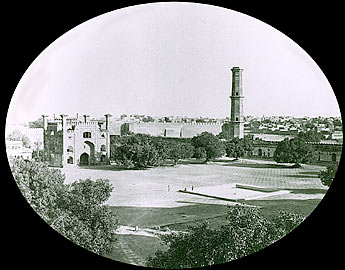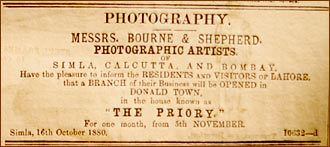| Samuel Bourne's name is synonymous with British Indian photography. He is the most researched and highly-praised colonial photographer. His work gave birth to a studio, Bourne & Shepherd, that still operates in Calcutta. Bourne's photographs have what his contemporaries described as a "luminiscient quality" that exemplifies classic Raj photography. Lahore, October 1864 Samuel Bourne #421 |
|
| All this, and Bourne only spent six years in India. Some credit for his success also goes to Charles Shepherd, an excellent printer in an age when chemistry was critical to a good photograph. |
| Bourne wrote a lively series on his adventures for The British Journal of Photography. They begin the day he arrived in Calcutta in 1863. It was an exciting time. He brought with him the chemicals to make albumen photographs. Newly invented, they were the first easily mass reproducible photograph. |
|
| Another reason for the success of Bourne, Sache and other photographers in India and elsewhere in the 1860s was newspaper advertising. It let photographers sell their work to widely dispersed customers. Despite Bourne's success, only one book (the best!) on him has been published, the out-of-print but beautiful Samuel Bourne: Images of India by Arthur Ollmann (Alibris, Amazon). Gary D. Sampson wrote the insightful article The Success of Samuel Bourne in India for History of Photography (Winter, 1992). Bourne's photographs appear widely in anthologies of British Indian photography. Hugh Ashley-Rainer has expertly compiled Bourne's fascinating entries about his photographic travels in India. Bourne PhotoIndex #: 794, 801, 1190, 1203, ?, ?. A 5 page summary of Samuel Bourne's career. A n online series of Samuel Bourne photographs. |
| ||||||||

